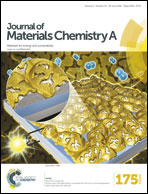Chelate-induced formation of Li2MnSiO4 nanorods as a high capacity cathode material for Li-ion batteries†
Abstract
Li2MnSiO4 with a theoretical capacity of 333 mA h g−1 is considered as a potential high capacity cathode material for lithium-ion batteries. However, it suffers from impure phases, low electronic conductivity, and poor cycle performance, which hinder its application in electric vehicles (EVs) and hybrid electric vehicles (HEVs). In this work, a chelating agent-assisted hydrothermal method was proposed to synthesize pure phase Li2MnSiO4 nanorods. Taking advantage of the strong chelating effect of ethylenediamine tetraacetic acid tetrasodium salt (EDTA-4Na), the reaction kinetics was substantially improved by changing the Mn source from Mn(OH)2 precipitate to soluble Mn-containing chelates, which simultaneously controlled the purity and nanoscale architecture of Li2MnSiO4. After coating with amorphous carbon, Li2MnSiO4@C with a 9% carbon coating exhibited a discharge capacity of 275 mA h g−1 in the initial cycle with a current density of 8 mA g−1 (0.05C, 1C = 166 mA g−1), and a better cycle property with a capacity retention of 115 mA h g−1 after 50 cycles was obtained with a higher carbon coating (19%). The good electrochemical properties may be attributed to synergetic effects of the high phase purity and well-dispersed one-dimensional morphology of Li2MnSiO4.


 Please wait while we load your content...
Please wait while we load your content...